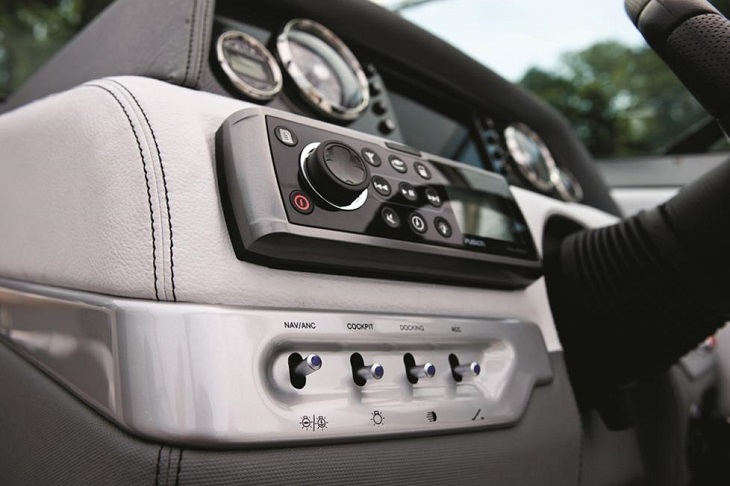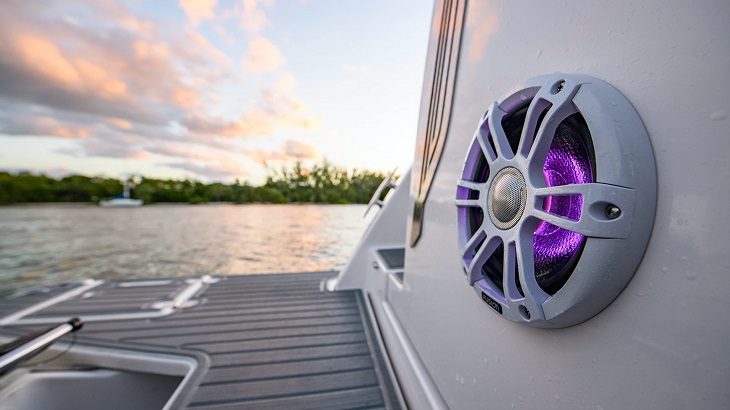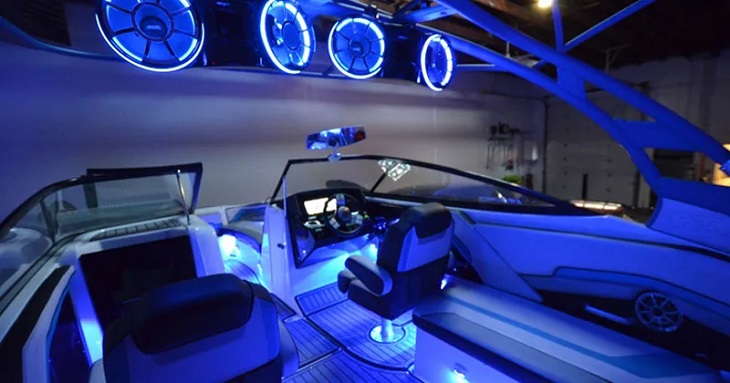Installing and building a stereo system at home or in a vehicle means you need a few basics – a power source, an amp, a player, speakers and cables to connect all the things. There are two paths that you can take. You can go for integrated systems and a pair of connected speakers, or custom-build a stereo to your liking. For cars and boats, there are cheap, featured all-in-one systems that fit within the dash or in separate consoles and gauges. Of course, you can get creative and build a system consisting of separate components, worthy of any concert hall. All units are powered by the onboard battery. Read on to find out what to look for in boat stereos.
Basics of Marine Stereos

Waterproofing
Whether you’re buying an integrated unit or separate components, they all need to be rated against potential damage from the most obvious thing when at sea, water and salt. Internal circuitry and the outer housings will be completely sealed to provide optimal performance in all conditions at sea. This means sprays, splashes or when the vessel is inundated in water. Salt will easily eat into a car radio if you’re thinking of using that as a cheap option in your boat. Speakers also need to be rated against water and salt spray, as they are the most exposed parts. Go for marine electrical cables when connecting all the parts. All dedicated marine radios and components are IPX rated. For more info about IPX ratings, see here.
Besides waterproofing, receivers, amps and speakers are rated for UV and chemical exposure. Since they’re in the open, Bluetooth stereo system for boat need to resist prolonged sunlight and heat, and still work at their best. For better visibility in direct sunlight, displays are backlit and covered in anti-reflective coatings.
Installation
You’ll find boat stereos that fit neatly in the standard gauge sizes in dashboards. Typically, these are circular 3” receivers. Alternately, you can get 2” DIN rectangular receivers. Most units are small enough to fit dashes with little or no dash modification. And since CDs are out, they won’t take up too much space. If you’re installing separate amps, do this in areas not directly exposed to water, preferably below the deck.
Some receivers can also be hooked up with your boat’s communications systems, providing better sound in navigation. Better units have anti-theft features, good when your vessel is unattended. Metal brackets and reinforced housings help here.
Features
This is where things start out cheap, and can easily go through the roof. Well-priced Bluetooth stereo systems for boats will have a decent sound quality and the most important features. This includes an RMS amp rating of at least 20W per channel in a dual speaker setup. More expensive integrated receivers can power two pairs of speakers at 50W or up to 8 speakers at the quoted minimal power rating. Outputs are the gold or gold-plated RCA type for connecting additional components, like subwoofer amps for a fuller sound. There are USB inputs for charging any mobile device. Bluetooth and built-in streaming apps allow for seamless pairing with all the music on your phone. Look for receivers with the latest Bluetooth codecs. All receivers have integrated AM/FM tuners to catch up on your favourite radio stations, while dearer models have satellite radio for crisp reception in any location. To get the best sound over airwaves, mount a band-sensitive antenna.
To change the volume, the radio station or song, boat stereos can be operated remotely with either wired or wireless remotes.
Integrated receivers are good for smaller boats. For larger vessels and for a louder, fuller and crisper sound, you can go the way of separate components. Digital marine amplifiers can power more speakers at higher outputs. The sound retains quality throughout the volume range due to low-noise circuitry made of the best conductors. They also include gold outputs to connect to music sources. This can be Bluetooth receivers or separate CD players, phono stages, network players and tuners which are best suited in the cabin.
Speakers

Speakers are either the ‘flush’ type that are installed in walls or the boxed speakers that can be mounted wherever you want. Careful speaker placement is important to flush out the sound of the engine and the sea. Larger speakers and subwoofers are better suited against thicker walls to amplify the bass.
Speakers come in different power outputs, with more expensive models having separate drivers for the lows, mids, and highs. More sensitive speakers are driven by less powerful amps. Like in any hi-fi setup, look for speakers rated at least double the amp output. Most are sold as single units or pairs or come packaged with integrated receivers along with connecting cables. Boat speakers are fully waterproofed, will stand up to UV and sunlight exposure, and are dust and salt spray resistant.
Buying Bluetooth Systems for Boats

Buy the system that best suits your boat and budget. Integrated units will have enough power, and very good sound with crisp, loud music for small to midsized boats. Bluetooth comes as a bonus, pairing things like phones, computers and headphones which can be charged in the USB ports. If you need more power and outputs, you can get a dedicated amp and subwoofer. Pair separate components of similar price points. Bluetooth boat systems are sold through stores specialising in boat supplies.


















